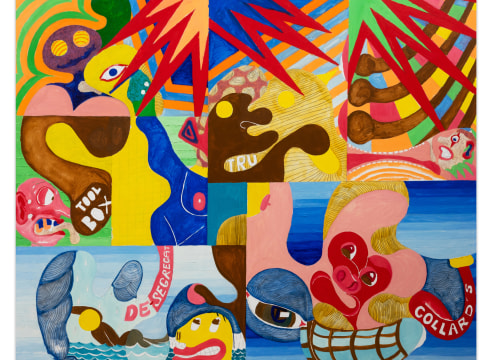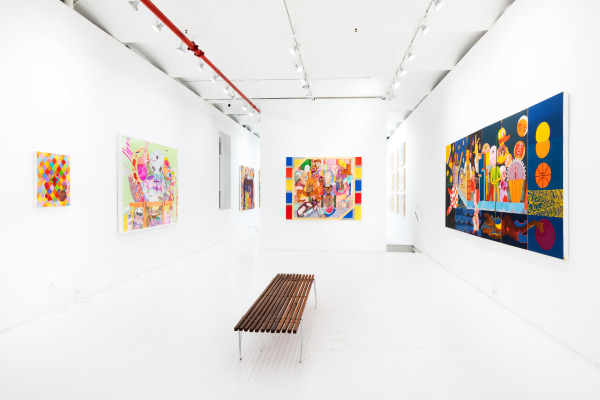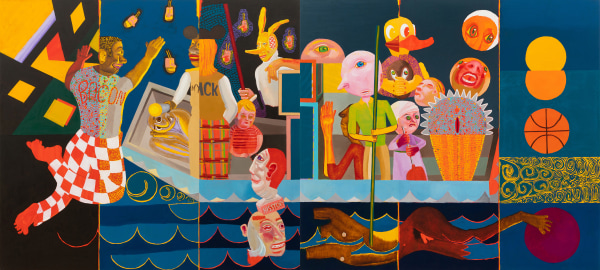
Peter Williams: Nyack
Eric Firestone Gallery
40 Great Jones | New York, NY
October 28–December 23, 2022
Opening Reception: Friday, October 28 | 6:00–8:00 PM
Eric Firestone Gallery is pleased to announce its exclusive representation of the Estate of Peter Williams (1952–2021) with a solo exhibition of his paintings.
Opening on October 28, Peter Williams: Nyack spans an approximately twenty-year period from the 1990s until his passing in 2021. This is the first posthumous presentation of the artist’s output. His work exists in the space between seductive beauty and abject horror—evoking the complex experiences of Black Americans in the contemporary age. On view through December 23, Peter Williams: Nyack showcases his critical place in the canon as a painter unafraid to tackle the most challenging personal and political subjects through a host of aesthetic approaches.
The artist was born and raised in Nyack, New York. Williams described that Hudson River Village as a place of relative racial diversity. Williams more fully grasped the struggles that Black Americans face after living in other parts of the country (Minneapolis, New Mexico, and Detroit among them). His childhood in Nyack was nevertheless complicated; his work reflects themes of verbal abuse and dysfunctional family life. The painter’s vision of his hometown became even more nuanced as he researched its history. Nyack was known as a landmark on the Underground Railroad—yet in the eighteenth century, nearly half of the wealthy families in town owned enslaved people. Nyack is also the title of a major 2013 diptych that Williams based on John Singleton Copley’s Watson and the Shark (1778). Copley portrayed a shark dragging a young white figure, Brook Watson, underwater. Watson would later become the Lord Mayor of London and would infamously defend the slave trade in the West Indies. In his own iteration, Williams replaced Watson with a swimming Black body with missing limbs—perhaps representing the artist himself, whose right leg was amputated following a car accident in his youth. Williams often depicted characters swimming, running, or playing sports. At times, they are fantasy alter-egos who freely escape familial and societal limitations. At other times, they appear immobilized by or even drowning in such pressures. Many works, such as Hubris (2013) and Desegregation (2020), incorporate bodies of water.
Often humorous and disturbing at once, his compositions at large evoke subjects ranging from police brutality and mass incarceration to the celebrities and places that inhabited his imagination. His paintings defy easy interpretation, as they layer autobiography with a multiplicity of references. His life stories coexist within more expansive historical and contemporary narratives.
Critics have connected his punk-pop style with Peter Saul and his revisionist history painting with Robert Colescott. Williams himself described the influence of artists ranging from Old Masters like Francisco Goya to early abstractionists like Wassily Kandinsky and Paul Klee to 1960s modernists like Frank Stella and Jasper Johns. Williams moved between and collided techniques such as geometric abstraction and pointillism while conceiving his own aesthetic vocabulary. His last paintings are divided by a single green line (perhaps a reference to Barnett Newman’s signature “zip” mark) with columns of eyes and facial features on either side. They suggest divisions between people across the country. As critic John Yau noted about the artist’s work, “There is nothing united about the United States, or the art world.”
Against this art historical backdrop, Williams’ oeuvre is densely packed with cultural icons. Mouseketeer hats, M&M’s, and historical minstrel imagery appear alongside heroes of the Haitian Revolution, Colin Kaepernick, and Leon Spinks in dizzyingly rich compositions saturated with outrageous color. Many of his paintings, and especially his last works, utilize multiple painted frames within the frame. These framing devices and his frequent use of the grid signify various forms of imprisonment and lack of representation: as a Black man, as a wheelchair-user, and as a storyteller entrapped in the legacy of modernism. “Each painting is a spectacle, a window that peers into an unsettling scene,” wrote critic Angela Carroll of his work.
A series called the N-Word depicts a Black superhero who intervenes in situations of violence enacted on people of color by the police. His NABA (National Association of Black Astronauts) body of work envisions an Afrofuturist narrative wherein Black people escape from cycles of oppression by traveling to outer space. As Williams once explained, “I use color and an outsider’s point of reference in my paint handling, creating an immediacy and a response that endows the work with a sense or feel of currency. … While it is painful, for some, that I bring a state of offensive literature, I think we are also deserving of a critique by looking at representations of race and representation.”
Peter Williams: Nyack will be accompanied by a fully illustrated catalogue with a text by Larry Ossei-Mensah and Ebony Haynes. Ossei-Mensah co-curated the artist’s 2020 solo exhibition at the Museum of Contemporary Art Detroit. He also curated Williams’s 2018 show at Cue Art Foundation, while Haynes contributed to its catalogue.
About the Artist
Williams began painting as a teenager before receiving his BFA from the Minneapolis College of Art and Design, and his MFA from the Maryland Institute College of Art.
The artist was known as a passionate mentor and instructor at the University of Delaware, where he began teaching in 2004 following a seventeen-year tenure at Wayne State University. He was the recipient of the Artists’ Legacy Foundation’s 2020 Artist Award and a 2021 Guggenheim Fellowship.
Recent exhibitions include Peter Williams: Black Universe, April–June 2020, Museum ofContemporary Art Detroit, MI; Peter Williams: With So Little To Be Sure Of, February–March 2018, CUE Art Foundation, New York, NY; Dark Humor: Joyce J. Scott and Peter Williams, February–April 2017, Center for the Arts Gallery, Towson University, MD; and Peter Williams: Artistic Repair, September–November 2007, Visual Arts Center of New Jersey, Summit, NJ.His work was featured in the 2002 Whitney Biennial and the 2017 edition of Prospect New Orleans.
Williams’s paintings are found in the collections of the Whitney Museum of American Art, New York, NY; Smithsonian American Art Museum, Washington, D.C.; Walker Art Center, Minneapolis, MN; Detroit Institute of Arts, MI; Delaware Art Museum, Wilmington, DE Nasher Museum of Art at Duke University, Durham, NC; and the Davis Museum at Wellesley College, MA, among others.


